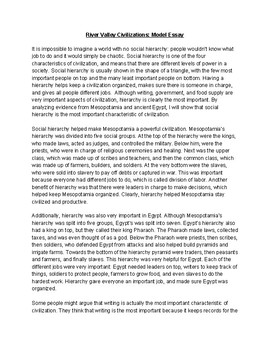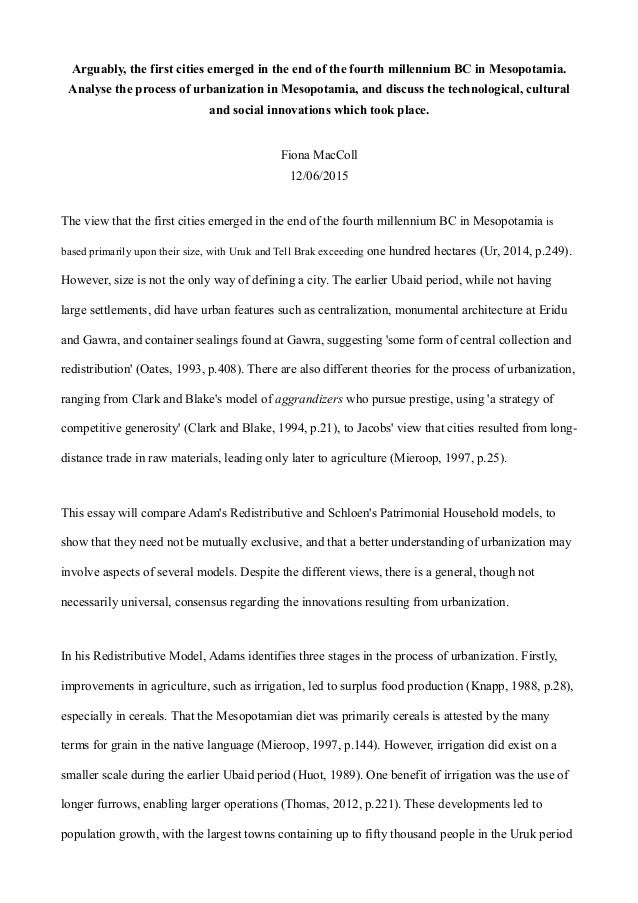
We've found 52 essays on Mesopotamia. Historiography: Mesopotamia. Mesopotamia is a historical region located in the middle east. There are two rivers tat run through Mesopotamia the Tigris and the Euphrates. The name Mesopotamia is Greek for “land between rivers” because of the Tigris and Euphrates rivers Mesopotamia Essay | Bartleby Essay On Mesopotamia. Mesopotamia was a place between two rivers. Mesopotamia is often called the land between two rivers. The rivers that Mesopotamia are called the Tigris river and the Euphrates river. It is in the middle of modern Iraq. mesopotamia is known for its rich soil, which is formed by the rivers
Mesopotamia Essays: Examples, Topics, Titles, & Outlines
This sample Mesopotamia Essay is published for informational purposes only. Free essays and research papers, are not written by our writers, they are contributed by users, so mesopotamia essay are not responsible for the content of this free sample paper. If you want to buy a high quality mesopotamia essay at affordable price please use our custom essay writing service. Mesopotamia is the ancient land between the Tigris and Euphrates rivers. It covers modern day Iraq and parts of Iran, Turkey, Syria, Lebanon, and Mesopotamia essay. Mesopotamian civilizations were the first in history to exist in well-populated and fixed settlements.
As settlements became larger and more organized, mesopotamia essay, they progressed politically and socially into city-states. They developed irrigation methods and invented the wheel and the plow. After they developed the first written language, economic transactions and legal codes were kept. Mesopotamian literature was recorded, mesopotamia essay. Great architectural structures were built, mesopotamia essay. In time, empires, kings, and innovative military establishments emerged. These advancements, along with scientific, mesopotamia essay, mathematical, and communal ceremonies, are the legacies of the great Mesopotamian civilizations.
Mesopotamia was the heartland of emerging nations and empires that would control the Near East for centuries. Mesopotamia is a general name for a number of diverse ethnic groups that contributed to the culture of the region. The most well-known Mesopotamian civilizations include the Sumerians, Babylonians, and Assyrians. Other cultural groups may have been key players on the Mesopotamian stage, but none was as influential as these groups. The Sumerians captured mesopotamia essay region beginning in the Early Dynastic period ca. Over these years, Sumerians developed the first writing system and created epic literature. Under an Akkadian Empire ca. Babylon was located in the mesopotamia essay part of modern Iraq, between Baghdad and the Persian Mesopotamia essay. At its cultural height BC to BCthe Babylonian civilization unified its Mesopotamia region.
Many adored Babylonian civilization because it was a melting pot of many ethnic groups. Even the emperors and barbarians who battled for control of Babylon preferred assimilation into its dynamic cultural heritage. Assur lay to the north in the Upper Tigris Valley and around the ancient city of Nineveh. Assyrians were a fierce cultural group, and the Assyrian empire reigned during a time of intense mesopotamia essay. Assyrian control constantly expanded and receded in its quest for complete domination of Mesopotamia, mesopotamia essay. At one time, the empire had expanded from Egypt, far to the east, to Iran in the west, mesopotamia essay.
At another time, Assyrian control receded to near extinction. The civilization reached its zenith from BC to circa BC but would eventually fall to a renewed Babylonian military. The first inhabitants of this Mesopotamian region settled in a broad range of foothills that surrounded the Mesopotamian plains known as the Fertile Crescent, mesopotamia essay. The region ran from central Palestine, north to Syria and eastern Asia Minor, and extending eastward to northern Iraq and Iran. During the historic periods known as the Mesolithic and Neolithic periods ca.
They settled into farming and herding communities. As they became skilled in animal husbandry and farming, they were able to produce more food and the population in this region soared. Although the villages in the Fertile Crescent became more sophisticated and sedentary, mesopotamia essay, the people migrated southward, into the Mesopotamian Plains, between and BC. Some families and clans may mesopotamia essay migrated to escape excessive population and overcrowding. Others may mesopotamia essay left due to social or political discontent. Still other evidence suggests that a great flood may have wiped out the shores surrounding the Black Sea and that mesopotamia essay settlers may have been refugees of this huge mesopotamia essay disaster.
The earliest Mesopotamians existed in a variable climate with a geography that included deserts, mountains, and river plains. Although northern Mesopotamia had adequate rainfall for successful agriculture, the mesopotamia essay regions required irrigation and skilled control of the Tigris and Euphrates rivers. Southern Mesopotamian settlements may have begun using irrigation principles as early as BC. Their ability to irrigate allowed growth in settlement populations, mesopotamia essay, which then created a need for organized communal work and complex hierarchical social structures. During these years, an immigrant group of settlers known as the Sumerians settled into the Mesopotamian region.
Sumerians were a very influential culture. Future peoples in this region preserved aspects of the Sumerian political and social customs as well as Sumerian literature and artistic style. Sumerians created the first wheel and the mesopotamia essay. Their skilled irrigation methods enabled an increase in food production. Sumerians rapidly turned agricultural communities into urban developments as they built the first cities. Sumerians also developed the writing system that enabled nobles and rulers to record economic transactions and legal decrees.
Sumerian city-states were independent of one another, and each was focused on controlling and supporting its farmlands and villages. The en represented the local god and managed the temple lands that the people entrusted to work on them. The lugal managed all civil, military, and religious functions of the city. The office of lugal seemed to mesopotamia essay at a time when defense walls were first constructed. As war became a constant threat, rulers became kings who would remain in power for mesopotamia essay lifetimes, passing rule onto their sons as successors to their thrones. As a state of dynasties took root, kings and royal families emerged. One of the most elaborate and impressive architectural structures of this time was the ziggurat, a multilevel platformed temple mesopotamia essay worship.
The oldest ziggurat was unearthed in the city-state of Ur. Leonard Wooley was the archaeologist who discovered most of what we know about this ancient city. He also uncovered ancient burial tombs that included not only the deceased but also physical possessions and domestic servants. Experts mesopotamia essay that the burial tomb included everything that the Sumerians believed would be needed for a comfortable afterlife. By the mesopotamia essay half of the third millennium, the Semitic-speaking people were a significant element in northern Mesopotamia, also known as Akkad. The most notable kings of the time were Sargon of Akkad and his grandson, Narcum-Sin, mesopotamia essay.
They enslaved Sumerian city-states and achieved control of the trade routes from the Persian Gulf to the Mediterranean, achieving for the first time a unified Mesopotamian region. Sumerian culture and cuneiform were retained, but Akkadian tongue became the mesopotamia essay language in Mesopotamia. The empire of Sargon and his grandson reigned for nearly a century. But the Akkadian empire mesopotamia essay then fall, leaving its legacy of imperialistic expansion, mesopotamia essay. The Third Mesopotamia essay of Ur came into power circa to BC. This Sumerian dynasty governed most of Mesopotamia and southwestern Iran.
Its founder, Ur-Nammu, mesopotamia essay, wrote the oldest known collection of laws, intended to protect the economically and politically weak. As this dynasty fell to pressure from the Amorites, another migration of Semites who originated west of the Euphrates, central imperial control disappeared, mesopotamia essay. According to scholars, the years following the Third Dynasty of Ur are called the Old Babylonian period — BC. For many years, Mesopotamia was disunited, with independent city-states frequently engaging in disputes and wars with its neighbors.
This time of intense conflict was a time of great political opportunity for the most powerful men in Mesopotamia. The most successful leaders to establish dynasties were Amorites, mesopotamia essay, who spoke Akkadian, and Elamites, who spoke a tongue unrelated to any others in the region. The Akkadian speakers settled a strong state in the city of Assur. When Ur fell to the Elamites, Assyrians became a leading political—military force. In BC, Shamshi- Adad overthrew Assur and established a new dynasty there. The attacks Shamshi-Adad did launch were relatively small scale and ceased after his death in BC.
His successor was then squashed by a Babylonian army led by the sixth king of an Amorite dynasty that had established itself circa BC, mesopotamia essay. This widely respected and feared king was known as Hammurabi and lived in Babylonia. Hammurabi also became the first king since Sargon of Akkad to unite the entire Mesopotamia land, stretching from the Persian Gulf to the Syrian border and the Armenian foothills. He was a skilled military leader and conqueror. Under his administration, trade flourished. He attended to domestic and economic issues while promoting literature, the arts, and science. However, the peaceful times he created diminished shortly after his death in BC. Eventually, the city of Babylonia fell to the Kassite nobles, who took the city in BC.
They were so impressed with the refined culture that they became assimilated into the Babylonian way, abandoning their native tongue for the Akkadian dialect of the Babylonians. In fact, the Kassites stabilized the region for more than four centuries, the longest period in Babylonian history. Great military innovations developed during the Old Babylonian period. The horse was domesticated. After the wheel was redesigned with spokes instead of a solid surface, horses were harnessed to chariots to enable military attacks en masse. The bow was also redesigned to fly faster and farther. These changes were implemented, and large-scale military action was possible, mesopotamia essay.
Mesopotamia essay Mesopotamians were famous for building elaborate palaces, the most impressive palace belonged to King Nebuchadnezzar II of Babylon — BC. In BC, mesopotamia essay, during a time that some modern scholars call the Middle Assyrian period, the Assyrians launched their first major mesopotamia essay in the northwest from the border of Hatti, through Armenia, and to the Zagros Mountains. In a series of small-scale attacks, the Assyrians use their newfound military innovations to take human captives, mesopotamia essay, horses, and other war booty. The Assyrians continued a second major front to seize Babylon and placed it under the rule of a monarch, Tukulti-Ninurta I, who reigned from to BC. Although this victory filled the Assyrians with great pride and satisfaction, mesopotamia essay, the great Babylonian nobles would rebel.
Mesopotamia: Crash Course World History #3
, time: 12:06Ancient Mesopotamia Essay

Mesopotamia, often called “the Cradle of Civilization,” was the birthplace of the world’s first civilization, Sumer. Mesopotamia was home to some of the world’s greatest civilizations as well—not only of Sumer and the related culture of Akkad but also of Babylonia and Assyria Essay On Mesopotamia. Mesopotamia was a place between two rivers. Mesopotamia is often called the land between two rivers. The rivers that Mesopotamia are called the Tigris river and the Euphrates river. It is in the middle of modern Iraq. mesopotamia is known for its rich soil, which is formed by the rivers We've found 52 essays on Mesopotamia. Historiography: Mesopotamia. Mesopotamia is a historical region located in the middle east. There are two rivers tat run through Mesopotamia the Tigris and the Euphrates. The name Mesopotamia is Greek for “land between rivers” because of the Tigris and Euphrates rivers
No comments:
Post a Comment